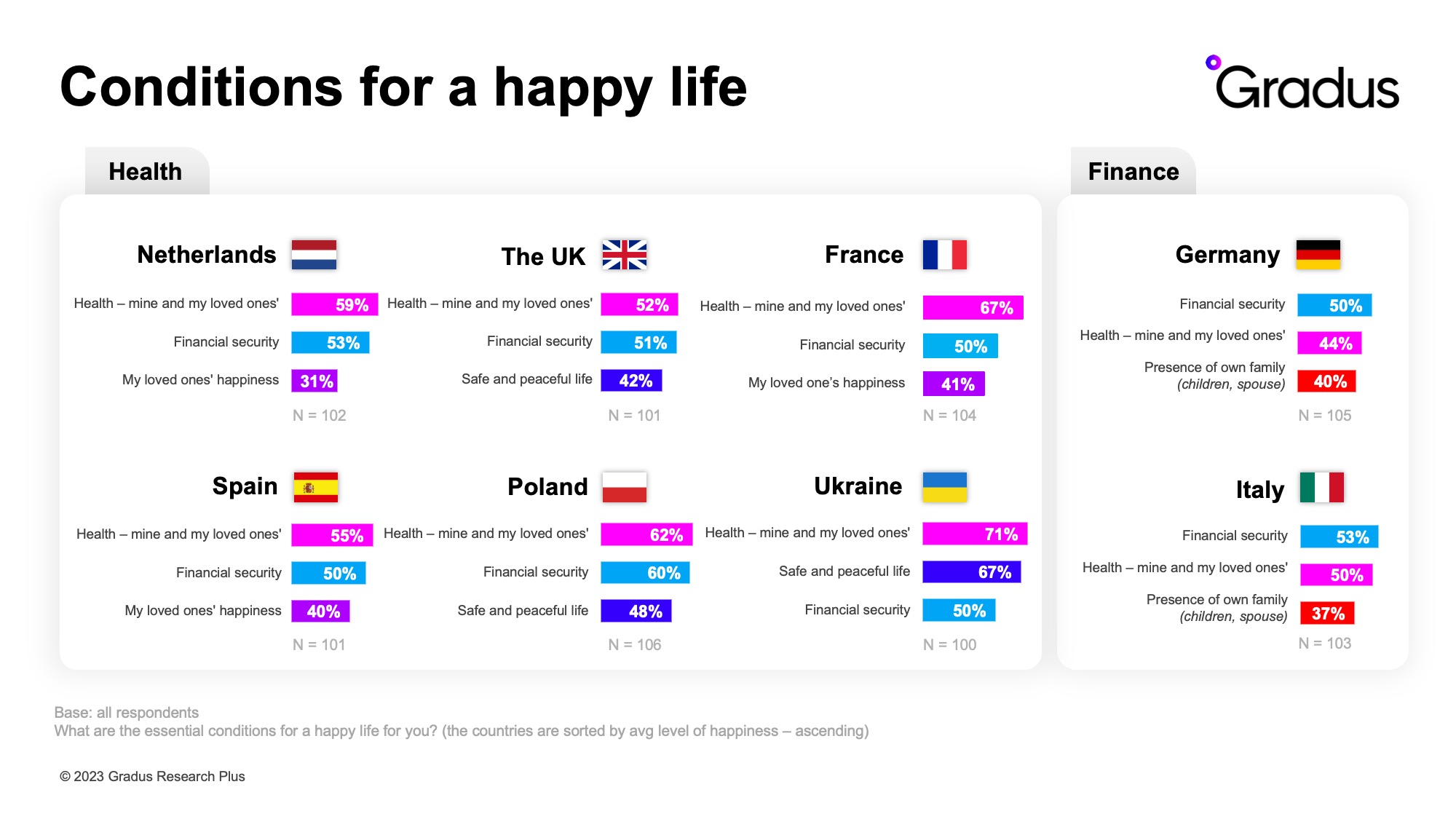Pay is not the only reason employees choose to stay in a role, writes Evgeniya Blyznyuk
People professionals regularly face challenges related to employee wellbeing, engagement, retention, and satisfaction with working conditions. To build a healthy workplace, it is important to understand the key needs and desires of staff. The results of a recent survey by Gradus Research showed that financial security is not the number one priority for a happy life among office workers, as it is commonly believed. There is something more significant.
The health of themselves and their loved ones is the top priority for 58% of respondents
To begin with, it is widely believed that the financial aspect is what office workers are most interested in. But when we surveyed the happiness index and priorities of white-collar employees in eight European countries (Germany, France, Italy, the UK, Spain, the Netherlands, Poland, and Ukraine), we found that the health of themselves and their loved ones is the top priority for 58% of respondents.
In six of the eight countries polled, it exceeds financial security in terms of importance, with the highest rates in Ukraine (71%), France (67%), Poland (62%), and the Netherlands (59%).

Of course, the relevance of financial security for a happy life cannot be overlooked – it is obvious – 52% of all respondents mentioned it. However, since the factor of health is rated higher than income, it is likely that a regular work schedule, the presence of a full-time psychologist in the company, or gym membership can be, in a complex way, more significant to respondents than a role with high financial rewards but irregular working hours, non-ergonomic office furniture, or lack of insurance.
It is also worth pointing out other vital factors for about a third of respondents: a safe and peaceful life (40%), the happiness of loved ones (34%), having a family of one’s own (33%), and interesting work (27%).
Know your people’s priorities
Why are these things important to consider? To ensure acceptable working conditions for employees, it is worth adapting the workflow to meet their needs. And it is better for companies to conduct such HR research regularly and individually because, depending on age, country of residence, and field of activity, people prioritise different aspects of life.
For example, the preferences of office workers of varying ages: we found that financial security is a primary condition for a happy life for 58% of respondents aged 45 to 55, while those between 25 and 34 are slightly less concerned about it (51%).
Conversely, when it comes to travelling, 28% of those surveyed aged 25 to 34 have stated its importance in life, compared to 20% in the 35 to 44 age group.
So, HR research helps build a people-centered organisation, not only in form but also in substance, as the focus turns to the needs of employees. This contributes to a culture of inclusiveness and sustainability in companies that become more proactive rather than reactive.
But what else, other than surveys, can we do to understand employee needs?
Empathise with your employees
For instance, an employee might struggle with remote work because they don’t feel fully integrated into the team and underestimate their impact on the company’s success. They might also feel disconnected if others work in the office or a hybrid setup.
By having open, constructive conversations, you can uncover these unspoken needs and adjust workflows accordingly, providing suitable conditions where possible. Simply being open to discussing these issues shows employees that their voices are valued.
Organise team-building events
This not only brings the staff together but also provides an opportunity to learn more about employees in a fun way.
For instance, a specific game where everyone draws a card and answers questions about their goals, dreams and travel plans can be quite insightful. It’s crucial that the questions aren’t too personal to ensure everyone feels comfortable.
Moreover, an HR specialist can actively participate in this process, fostering engagement and connection. In my opinion, you can’t expect to get to know people well if you’re not willing to share about yourself. By demonstrating openness and being willing to discuss your own aspirations and goals, you create an environment where others feel encouraged to share their thoughts too.
Look out for non-verbal signs
And finally, my last piece of advice is to be observant. This means not only staying up-to-date with news and trends in the people and work sphere online but also being attentive in the workplace.
Employees often communicate non-verbally, and body language can reveal a lot about their emotions. Sometimes, even when employees aren’t ready to verbalise their concerns, they communicate them non-verbally. Being observant of these cues can help you better understand your team members.
Combine research with hands-on approaches
This type of research plays a crucial role in grasping the requirements of staff members. However, it’s beneficial to complement surveys with various methods of interacting with staff to foster effective teamwork within the organisation and enhance overall satisfaction with work and life conditions.
By combining research with hands-on approaches, such as open communication, team-building activities, and being observant of non-verbal cues, you can create a supportive and fulfilling work environment that promotes employee wellbeing and productivity.
Evgeniya Blyznyuk, is a sociologist and CEO & Founder of Gradus Research




